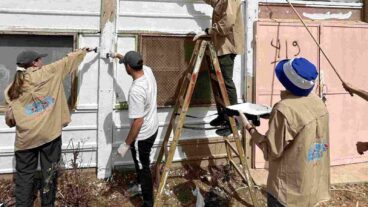In a quiet corner of rural Israel, a group of schoolchildren is trying to save a globally threatened species. Every winter, the kids prepare nesting boxes for the lesser kestrel, (Falco naumanni), a small falcon that is rapidly declining in Europe and the Middle East.
Then, they wait.
Sometime in February, the males arrive to search out a suitable nesting place. A few weeks later, the females arrive to mate and nest.
“Fewer birds come to breed here every year,” Shalom Terem, the principal of the Alona Regional School, tells ISRAEL21c. “But we are doing everything we can to preserve and strengthen their population.”
This includes protecting the kestrels from predators such as feral cats and owls, looking after nestlings and treating injured birds.
The lesser kestrel breeds in the spring and early summer across the Mediterranean region before continuing its migration from southern Africa across central Asia to China. An estimated 2,000 to 3,000 pairs once bred in dozens of natural colonies across Israel. Now only a handful of lesser kestrel breeding grounds are left.
The last countrywide survey found only 566 breeding pairs, mostly in greater Tel Aviv, Jerusalem, Megiddo, Safed and Alona, where 109 pairs were spotted – and that was 12 years ago. In all likelihood, fewer than 550 lesser kestrel pairs now breed in Israel.

“In the past half century the numbers have dropped drastically, although this decline seems to have evened off in recent years – but not here in Israel,” says Dr. Adiv Gal of Kibbutzim College, who heads the school’s preservation project.
Gal notes that “the children don’t just study the birds — they play an active role by physically building the nesting boxes. This makes them feel part of the effort to save the birds. This year, 13 of the 29 nesting couples are in our boxes.”
Transmitting a passion for birds
Part of the reason for the boxes’ success, says Gal, is a change in local building practices.
“The lesser kestrel does not build a nest of its own; rather it utilizes ‘dimples’ in cliffs or trees. There used to be a time when they would make their nests in the space under roof tiles, but nowadays most houses in Israel are built with concrete walls flush with the roofs, leaving no such gap.”
The lesser kestrel has been part of Gal’s life since 1999. “My doctoral thesis at Hebrew University of Jerusalem was on the lesser kestrels of Alona and the Jerusalem area. I’m fascinated by this bird.”
It seems that Gal’s passion for the subject has rubbed off on his students.
“The program has been ongoing for 16 years and is now stronger than ever,” notes Terem, the school principal.
“Every year a different fifth grade takes it on. The fifth-grade classes devote two study hours a week to the birds and are responsible for maintaining the nesting boxes and gauging the birds’ progress. All of our first- to sixth-graders are involved in some fashion – when they’re not busy maintaining the school’s petting zoo. The baton is passed from year to year, while the younger kids wait for their chance.”
Terem talks with pride of his school’s unique study track.
“We had 1,300 guests on our Open Day this year, including a delegation from the Palestinian Authority and Jordan. The children themselves – not their teachers or parents – guided the visitors for group tours of the project.”
Ultimately, he says, the aim is to preserve the lesser kestrels and help their numbers grow until they can be removed from the list of globally threatened birds.
Real-time broadcasts
Three years ago, the Israeli security company G4S donated a set of infrared video cameras that broadcast live 24/7 from inside nesting boxes via the Internet.

“Every classroom in the school has an Internet connection and large screen,” notes Terem. “A few weeks ago I sat with some of the children transfixed for an hour, watching a chick hatch and gradually emerge from its egg — and missed an important meeting. It’s gripping to watch the mothers feed the chicks, bringing them mice, in real time.”
Established in the late 1950s, the Alona Regional School in Moshav Amikam serves children from Amikam, Givat Nili and Aviel, plus about 30 children from nearby towns. Twenty-one years ago, the school became part of the Tali network, an educational system in which non-Orthodox schools or classes within schools offer enriched Jewish studies.
“We have room for 310 students and a very long waiting list for places,” says Terem. “The Jewish studies attract parents and children alike – and so does the lesser kestrel preservation project.”
But children that age can be fickle. How do you maintain their interest?
“That’s not a problem,” shrugs Terem. “This is one fascinating subject. It’s also active and outdoors. It takes them away from screens and into the fields. The kids love watching the birds and monitoring their progress in the field.”
Terem was speaking to ISRAEL21c in the last week of June, when the sounds of the birds abruptly stop.
“Just as the school year ends, they leave us. The children believe they know it’s time for the summer vacation and fly away.”

















